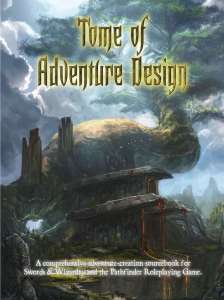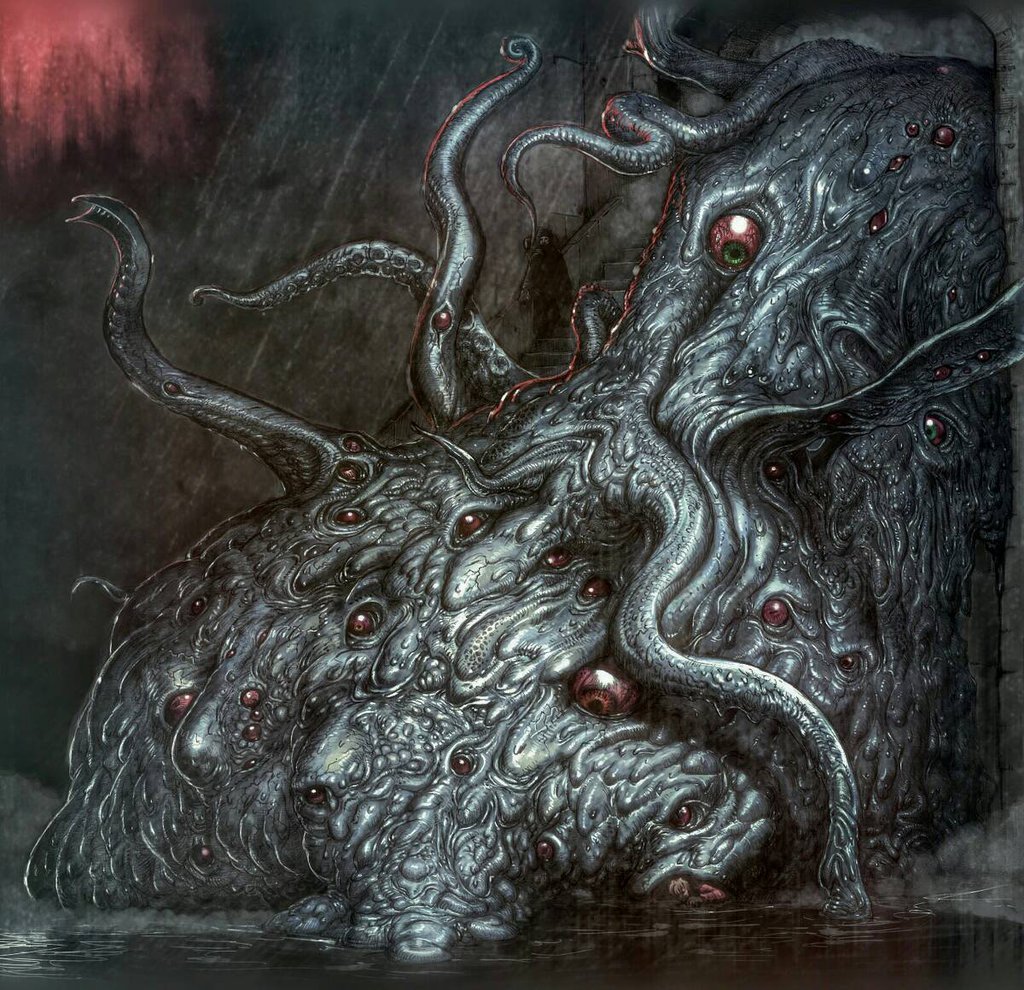Back in 1987, Dragon magazine issue 122 published “The GM’s Ten Commandments: Ten dos and don’ts for game masters everywhere,” a list of tips that author Rig Volný likely wrote 35 years ago. Since then, play styles and advice for game masters have evolved. How well have the commandments stood the test of time? Roman numerals count off the original commandments; my updates appear in boxes.
I. Do not consider the players as adversaries.
The article explains, “In role-playing, the situation is not one of GM vs. players: It isn’t a fair fight.”
In 1987, many GMs framed players as adversaries. Now, everyone sees this as a bad mindset, but today’s advice goes farther.
1. Be a fan of the characters.
The Dungeon World (p.162) game recommends thinking of the players’ characters as protagonists in a story you enjoy. “Cheer for their victories and lament their defeats. You’re not here to push them in any particular direction, merely to participate in fiction that features them and their action.”
 As a fan, GMs still get to test characters. In Your Best Game Ever (p.93), Monte Cook recommends game masters take this approach: “Have a playful attitude of, ‘I’m making this really challenging for you.’ This isn’t adversarial, just a way to—on a metagame level—inject a bit of tension into the game. When the PCs are victorious, the players will feel even greater satisfaction from believing that you were pushing them to their limits.”
As a fan, GMs still get to test characters. In Your Best Game Ever (p.93), Monte Cook recommends game masters take this approach: “Have a playful attitude of, ‘I’m making this really challenging for you.’ This isn’t adversarial, just a way to—on a metagame level—inject a bit of tension into the game. When the PCs are victorious, the players will feel even greater satisfaction from believing that you were pushing them to their limits.”
II. Never say “You can’t do that.”
The original article cites two cases when a GM might make the mistake of telling players, “You can’t do that.”
- When players want to attempt something very difficult or even impossible.
- When players want to violate their characters’ alignment.
“The point of this commandment is that it gives the players a degree of control in the game—one that adds desirable unpredictability. This makes the GM ‘play’ the adventure rather than just direct a prewritten script.”
Sometimes as GMs, we imagine our games will follow a particular path, all according to our plans. Perhaps we devise a clever puzzle or challenge and want it to work so players can appreciate our ingenuity. Perhaps we lay twists for future sessions. Sometimes we favor a game that sticks to the comfort of familiar rules rather than one that strays into untested judgement calls. When the game veers from plan, we feel tempted to nudge or even wrench it back on course. Remember this temptation, because the GM’s 10 commandments will suggest ways to avoid succumbing.
When players try some stunt that might launch the game in an unexpected direction, let them. “If a player attempts a difficult task, have him make a difficult die roll.”
The article acknowledges that some tasks are impossible, and then suggests giving the player a clearly impossible die roll such as a 7 on 1d6 to avoid saying, “You can’t.”
Usually players who ask to attempt something impossible are confused by the situation in the game world. For example, they picture jumping a 3-foot wall when they actually face 25 feet of stone. Asking for a roll of 7 on a d6 just feels like mockery. Instead of this suggestion, substitute guidance inspired by my 4 Unwritten Rules No Dungeon Master Should Break.
2. Whenever players attempt a difficult or risky task, make sure the players know the odds and the likely result of failure.
For impossible tasks, you can say, “You can’t.”
As for a character who violates a good alignment by attacking innocent people, the article suggests letting in-game consequences result. “Don’t tell him he just doesn’t do that sort of thing. Let the local constabulary enforce his conscience.”
In 1987, Dungeons & Dragons emphasized alignment as the one rule that limited a character’s behavior. Characters whose actions failed to match their alignment faced punishment. However, as long as characters remained true to their evil alignment, then torture and murder just rated as good roleplay. By the ethos of 1987, any game master who interfered with a player’s freedom of action was guilty of an abuse of power. Now, gamers focus more on how disruptive that sort of play can become.
3. Decide with your group about the sort of game everyone wishes to play and insist that players create characters that fit that game.
As a game master doing the heavy lifting, you deserve at least as much say as the players. If you want characters in your Curse of Strahd game to play do-gooders who help folks, rather than evil types seeking an alliance with Strahd, ask players to imagine characters who fit that campaign.
As a player, your first role-playing obligation is to imagine a character who can cooperate with the rest of the party to achieve the common goals of the game. (See A role-playing game player’s obligation.)
III. Don’t overplan.
“Overplanning prevents the GM from meeting the actions of the players with flexibility and interferes with spontaneous creativity.” This commandment circles back to avoiding the temptation to limit players to particular path. “If the GM prepares extensively for the players to do A, B, or C, and they do D instead, he is faced with the temptation to dismiss a good plan as irrelevant to play.”
The commandment still holds, but in The Return of the Lazy Dungeon Master, Mike “Sly Flourish” Shea offers a more useful refinement.
4. Prepare what benefits your game, and omit what does not.
All GMs and groups are different, so what you need to prepare to run an RPG session varies. Mike’s Lazy Dungeon Master argues that most game masters benefit from less preparation rather than more, and then describes the steps most likely to benefit a session.
For me, preparation lets me reach past the “stereotyped situations” that I might improvise to find more evocative ideas. Lazy Dungeon Master (p.21) recognizes the same dynamic when it recommends preparing secrets for a session. “Sometimes thinking up ten secrets is hard. But as you wrack your brain for those final few, you’ll often come up with the most interesting ones. It sometimes takes great mental effort to dig deep into one’s mind and find the diamonds buried within.”
The article gives the example of a GM who spends 12 hours designing a dungeon lair just to see the players find a way to skip it. Dungeons rate as higher-prep scenarios. To avoid such wasted design, ask the players to outline their plans for your next session so you can prepare with more certainty.
IV. Keep adventures within reason.
This commandment recommends two types of restraint that seem unrelated to me.
- “Don’t engage in stereotyped situations.”
- “Don’t cheapen magic, gold, or fantastic creatures by making them too common.”
The article cites examples of the “stereotyped situations” that GMs should avoid, including ultimate battles between good and evil, one-dimensional characters, and totally evil bad guys. As a counterpoint, Dungeon Master 4th Edition for Dummies (p.54) advises, “Don’t be afraid to make your villains totally evil. The worse they are the more satisfying it will be for player characters to defeat them.” Games that avoid overused tropes can feel fresher, but this tip fails to merit a commandment.
The second limit seeks to avoid D&D’s classic problem of magical loot breaking the game. “When a beginning party starts to collect scores of magical items, the members begin to obtain a degree of strength that is often out of proportion with their level.” Thanks to item attunement and better guidance on treasure rewards, today’s D&D game does a better job of avoiding this trouble, even without a commandment. (See Too much magic kept breaking Dungeons & Dragons—how fifth edition fixes it and What is the typical amount of treasure awarded in a fifth-edition Dungeons & Dragons campaign?.)
As for the bit about cheapening fantastic creatures by making them too common, tastes vary, but in most D&D worlds “monsters are everywhere.” The Dungeon Master’s Guide (p.9) gives advice for DMs who prefer to imagine worlds with rare monsters.
V. Run the adventures in color, not in black and white.
The article cites an example of boring play to avoid.
Player: We ask around to see if there’s a tavern in the town.
GM: There’s one a mile up the road.
Instead, the author recommends acting out the scene, complete with an accent for the NPC. In many situations, acting as an NPC creates a more vivid and dramatic game. Dungeon Master 4th Edition for Dummies (p.54) explains, “Whether an NPC serves as a walk-on or has a minor or major role in the story, play each one as an individual. Roleplay! Nothing makes an NPC come alive like roleplaying a key feature to give him or her personality and pizzazz. For major NPCs, such as the dastardly villain or the regal king who hires the adventurers, roleplay to the hilt. Even the lowliest kobold minions, though, really come alive if they have distinctive voices—even if all they ever say is, ‘I am slain!’ Ham it up, act it out, and make each character memorable in the scene.”
5. Roleplay your supporting cast as if you are a player and each NPC is your character.
The article’s example of getting directions leads me to a quibble: The example expands a two-line exchange between player and GM into inches of text, wasting time by exaggerating the importance of a minor moment. Because the GM gave the bystander so much attention, the players will keep talking, seeking the apparent importance in an inconsequential exchange.
Typically, an interaction without (1) a goal and (2) an obstacle only merits the sort of summary in the “boring” example. See How to Use Scenes and Summaries to Focus on the Best Parts of a Role-Playing Adventure. If the bystander happens to have more backstory to share, you might drop into character for a more colorful delivery. For a full scene, introduce a minor obstacle for the players to overcome. “I really shouldn’t say. The sheriff doesn’t approve of adventurers. Not since that last bunch.” Now the players need to find a way to overcome the NPC’s reticence, and the information shared seems worthy of attention.
Next: Can I update commandments 6-10 into exactly 5 more tips? Check back next Tuesday.
 Typically, roleplaying encounters combine an objective of gaining information or help, with the obstacle of an uncooperative non-player character.
Typically, roleplaying encounters combine an objective of gaining information or help, with the obstacle of an uncooperative non-player character.












